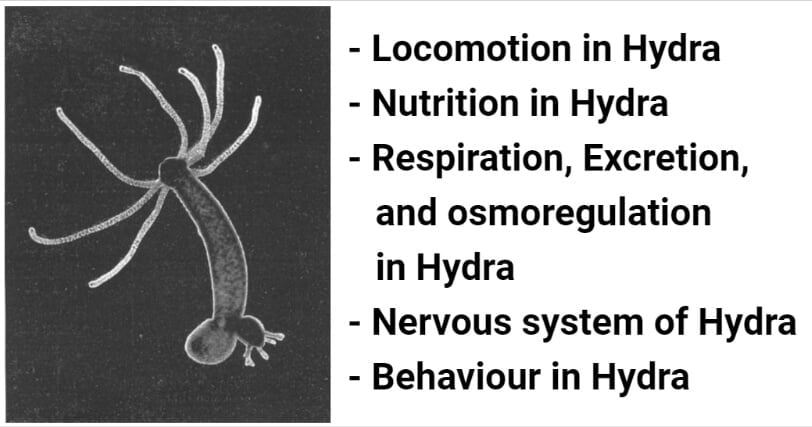
Interesting Science Videos
Locomotion in Hydra
- Hydras are essentially sessile animals. They live attached by their pedal discs to objects in the water.
- Brown and green hydras can remain fixed at one spot for a considerable time, but green hydras often move about from place to place by several ingenious devices. They twist about or perform movements to change their location either in response to light or some chemical stimulus or to obtain food.
- All the movements of hydras are due to contractions of the epidermal muscle fibers largely as their gastrodermal muscle fibers are less developed.
- Organs that help in locomotion are Basal disc, tentacles, and epitheliomusclualr cells.
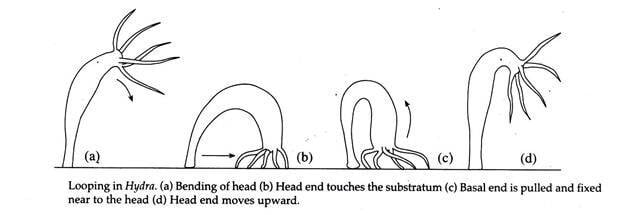
Image Source: Notes on zoology.
Hydra shows the movement of the following types:
1. Expansion and contraction
- Hyrda, attached to a substratum in water, frequently expands and contracts itself at intervals. This behavior of Hydra is called contraction burst which is initiated by a pacemaker located near the base of the hypostome.
- These movements allow Hydra to contract (shorten) and extend their body in order to capture prey using their tentacles.
- Also, the contraction of one side and elongation of another side of the body or tentacles result in the bending and swaying movements that assist in the capture of prey.
2. Looping
- Hydra can move from place to place in search of food by looping.
- During looping, usually, the body first extends and then bends over, so the mouth and tentacles attach to the substratum with help of adhesive glutinant nematocysts.
- Then the pedal disc is released and brought up to closer to the circlet of tentacles and then attached. The animal then stands up by making free its tentacles. The whole process, which repeated again and again and appears like a series of looping movements of a caterpillar or leech.
3. Somersaulting
- It is another method of rapid movement which is a slight modification of looping locomotion.
- In this method, the tentacular end of Hydra is brought forward and attached to the substratum. The pedal disc is freed and moved upwards, this causes the Hydra to assume an inverted posture. Now, the pedal disc is then rotated 180°and is fixed to a new position. By freeing the tentacular end the animal again assumes its upright position.
- When in a hurry, the animal runs by performing a series of somersaults.
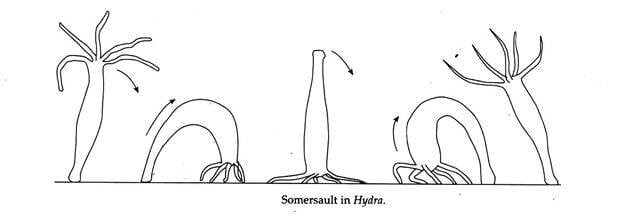
Image Source: Notes on zoology.
4. Gliding
- For moving a short distance Hydra simply slides along on its basal disc aided by secretion from mucous glands. This is the type of movement that resembles snails.
- It can slide or glide slowly over the substratum due to the creeping amoeboid movement of cells of the pedal disc. Considerable distances are sometimes covered in this manner.
5. Walking
- This type of movement involves the use of tentacles. Hydra moves in an inverted condition, using its tentacles as legs to move from one point to another.
- This type of movement takes place on some objects such as leaves and in leisurely hours.
6. Climbing
- Pelmatahydra can change its location in limited areas. Hydra climb by attaching its long tentacles on some objects, releasing the foot, and then contracting the tentacles, so that the body is lifted up to a new position.
7. Floating
- Occasionally, Hydra throws its body free and floats on the water surface with waves.
8. Surfacing
- Sometimes Hydra uses a gas bubble, secreted by some ectodermal cells of the basal disc cells which helps the animal to rise and float on the surface.
- The animal is passively carried from one place to another by water current or wind below.
- If the gas bubble bursts, the mucous threads sustain the body on the water surface due to surface tension.
9. Swimming
- Sometimes Hydra frees itself from substratum and swims in water by undulating, wave-like movements of tentacles and body in a similar fashion to squids.
- A characteristic feature in the behavior pattern of Hydra is the periodic contraction. It happens without any apparent cause even when the animal is attached and undisturbed.
- Hydra contracts its body and tentacles suddenly and rapidly at every 5-10 minutes at day time, becoming like a small barrel. After a short period of rest, the body and the tentacles gradually get extended in a new direction. According to McCullough (1963); such movements bring the animal into new hunting grounds, where more food may be available.
Nutrition in Hydra
1. Food
- Hydra is almost exclusively carnivorous.
- The food of Hydra consists of small aquatic animals such as insect larvae, crustaceans(e.g., Cyclops, Daphnia), and annelid worms.
- It may swallow prey larger than itself, such as young fish and tadpoles.
- Hydra can damage trout nurseries by preying upon newly hatched young.
- It can also feed on small bits of meat in an aquarium.
2. Ingestion
- Coelenterates are the first animals to use projectiles, called nematocysts(stinging cells), for capturing animals.
- A hungry Hydra waits for its food, it normally rests with its basal disc attached to some object, while its body and tentacles extend out in the water.
- When prey touches a tentacle, dozens of nematocysts are discharged into it at once.
- The solvent coil around bristles and other appendages on the pre, while glutinants fasten to its surface, thus holding it fast.
- The penetrants puncture the victim and inject the paralyzing hypnotoxin.
- The tentacles, holding prey, now contract and bend inwards, the other tentacles also bend and helps to draw the paralyzed prey towards the mucus-lined mouth, which opens widely to swallow it. The muscous secretion helps in swallowing.
- The contraction of the hypostome and body wall (peristaltic movements) force the food down into the gastrovascular cavity where the digestion takes place.
- It has been shown that it will engulf only these animals which contain chemicals called glutathione, usually found in the tissue fluids of most animals. The glutathione is necessary to evoke the feeding reaction.
3. Digestion
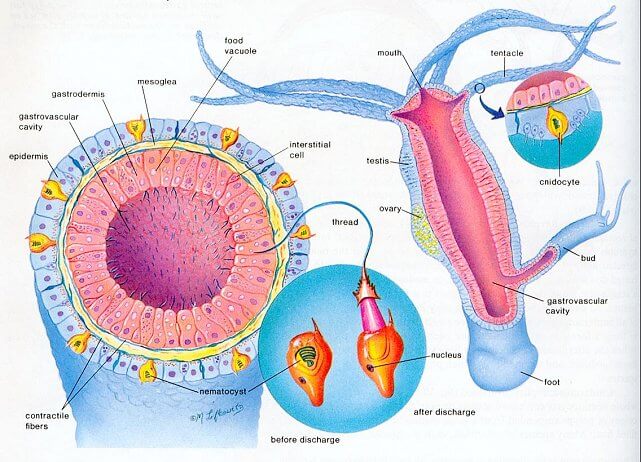
Image Source: Muhammad Tahsin.
The gastrovascular cavity acts as an enteron “intestine” where is both extracellular and intracellular digestion occurs. The single opening of this gastrovascular cavity is the mouth serving as both ingestion and egestion This type of digestive system is known as the incomplete digestive system.
a. Extracellular digestion
- By the action of digestive juices secreted by the gland cells of the gastrodermis, the prey is killed.
- Churning movements caused by the expansion and contraction of the body wall and lashing movements of flagella of nutritive-muscle cells thoroughly mix up the digestive juices with food which is broken into smaller particles suspended in a meaty broth.
- The digestive enzymes now act upon the disintegrating food. A proteolytic enzyme like trypsin partly digests proteins into peptides. This type of digestion, occurring in the cavity, outside the gastrodermal cells, is called extracellular digestion which is purely proteolytic.
b. Intracellular digestion
- The smaller fragments of food are engulfed by nutritive-muscle cells by means of pseudopodia and digested within vacuoles. This is intracellular digestion.
- Studies have revealed that food vacuoles undergo both acidic and as well as alkaline phases, and digestion of protein is completed by other proteolytic enzymes.
- Digestion in Hydra combines both intracellular digestion of lowe (Protozoa and Porifera), and extracellular digestion of vertebrates
- Retention of intracellular digestion is probably due to its aquatic mode of life, as the digestive juices get diluted in the gastrovascular cavity.
4. Absorption
- In Hydra end product of digested food is absorbed by endodermal cells and distributed by diffusion from cells to cells.
- The gastrovascular cavity serves for both digestion and circulation.
- Hydra can digest proteins, fats, and some carbohydrates but not starch.
- The reserve food materials, chiefly glycogen and fats, are stored in some of the gastrodermal cells.
5. Egestion
- The indigestible residues, like the exoskeleton of crustacea, are egested through the mouth due to muscular contraction of the bod
- The mouth thus functions as the anus.
Respiration, Excretion, and osmoregulation in Hydra
- Hydra has neither blood and blood vessels, nor organs of excretion and respiration, which are carried on individually by each cell.
- Due to the thinness of the body wall and circulation of water in the gastrovascular cavity, most of the cells of the body remain freely exposed to the surrounding water. Therefore, the gaseous exchange occurs directly by diffusion through the general body surface.
- Nitrogenous wastes are largely in the form of ammonia, which also diffuses through the body surface.
- The waste matter left out after the digestion of food is thrown out of the body through its mouth, which performs the function of the mouth as well as the anus.
- It is also thought that the gastrodermis of the basal disc is said to accumulate some excretory matter, which may be discharged through a pore.
- In Hydra, the gastrovascular cavity is responsible for osmoregulation by removing the excess fluid from the gut. The fluid releases under pressure by breaking the body wall due to the strong contraction.
- They release excess fluid by contracting and excreting it through the mouth.
Nervous system of Hydra
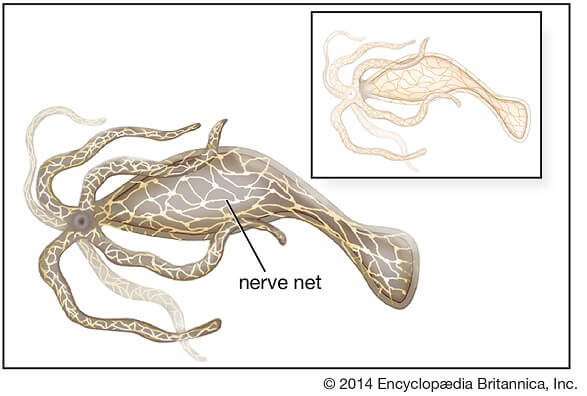
Image Source: Encyclopædia Britannica, Inc.
- Hydra possesses a very primitive type of nervous system because they do not form axons and dendrites.
- It includes bipolar and multipolar nerve cells or neurons lying immediately above the muscle processes forming an irregular and discontinuous nerve net or nerve plexus.
- It is made up of about 6.000 nerve cells.
- The species of Hydra have two nets, one located between the epidermis and the musculature and the second associated with the gastrodermis.
- Their processes are connected to sensory cells, which act as receptors for external stimuli, and to epithelio and endothelio-muscle cells which act as effectors by contracting their muscle processes. Such a combination of muscle processes of epithelio-muscle cells, sensory cells, and nerve net is referred to as a neuro-muscular system.
- Nerve cells are more concentrated in a ring near the pedal disc and the hypostome (the “mouth”),
- The nerve net of Hydra is unpolarized so that impulses can pass in all directions (diffuse transmission).
Behaviour in Hydra
Hydra reacts to various kinds of internal as well as external stimuli. The behavior of Hydra depends on its physiological state, in a well-fed Hydra the stimuli responses slow and sluggish, but a hungry Hydra will respond vigorously to the same stimuli. However, Hyrda responds to various stimuli in the following ways:
1. Reactions to internal stimuli
- Hydra shows spontaneous movements of the body and tentacles in response to internal stimuli.
- At regular intervals, body, or tentacles, or both contract suddenly and rapidly and then slowly expand in a new direction.
- In well-fed Hydra, such, movements are slow. These movements are produced by muscle processes when they are stimulated through a nerve net.

Figure: Spontaneous contractile behavior of Hydra. Image Source: https://doi.org/10.1038/s41598-017-16191-x
2. Reaction to external stimuli
- Hydra responds positively or negatively to an external stimulus, depending upon its type and intensity.
- The animal usually responds negatively if the stimulus is strong.
- The movements are produced by contractile muscle processes in the wall when they are stimulated through a nerve net.
a. Contact
- When floating or swimming Hydra comes in contact with substratum, it gets attached to it with the pedal disc.
- If the tenatcles are touched, stimulus causes the contraction of one or all tentacles together with or without the body. This shows that the stimulus of transmission is conducted in all directions by the nerve net.
- The response of stimulus is greater near the point of contact and progressively decreases in more distant region because each nerve net offers some resistance to the passage of impulses, the resistance occurs at numerous nerve cells.
b. Light
- Hydra responds negatively to both strong as weak light.
- It prefers to accumulate in a region of moderate light intensity. Thus, the animal has an optimum with regard to light.
c. Temperature
- Hydra prefers cool or cold waters and disappears from the surface when the temperature reaches 20ºc to 25ºc.
d. Electric current
- When Hydra is subjected to a weak and constant electric current, its tentacular end bends towards the anode and pedal disc towards the cathode. The whole of the body and tenatcles then contract.
- When the animal is inverted with tentacles attached to the substratum, the pedal disc bend towards the anode, and the tentacular ends towards the cathode.
e. Water current
- Hydra shows no reaction to water currents.
f. Chemicals
- Hydra avoids strong and injurious chemicals but exhibits a positive response to food.
References and Sources
- Kotpal RL. 2017. Modern Text Book of Zoology- Invertebrates. 11th Edition. Rastogi Publications.
- Jordan EL and Verma PS. 2018. Invertebrate Zoology. 14th Edition. S Chand Publishing.
- https://www.studyread.com/hydra-biology/ – 14%
- https://www.biologydiscussion.com/invertebrate-zoology/phylum-coelenterata/hydra-history-habitat-and-locomotion-with-diagram/28686 – 11%
- https://www.notesonzoology.com/marine-animals/locomotion-in-hydra-with-diagrams-marine-animals/1881 – 10%
- https://shreeya-biologyworld.blogspot.com/2012/06/INTERNET8%https://www.britannica.com/animal/Hydra-hydrozoan-genus – 1%
- https://www.thoughtco.com/plant-tropisms-4159843 – 1%
- https://en.wikipedia.org/wiki/Gastrovascular_cavity – <1%
- https://www.csus.edu/indiv/r/reihmanm/platyhelmintes_and_nematoda.htm – <1%
